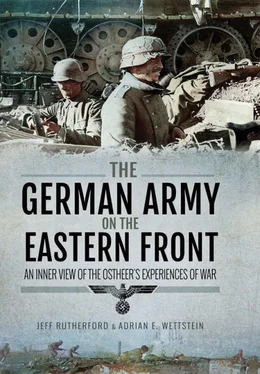There were some suitable men in the replacements. A large part, however, is almost unfit for front service due to physical ailments (hardness of hearing etc.) or susceptibility to diseases (age group 1907). The replacements’ level of training is not sufficient in terms of engineer tasks and military basic training.
In addition to the lack of both adequate basic and specialist training, the first signs of the evanescent German manpower pool appeared, with the need to send men to the front with physical handicaps.
More detailed in describing the training deficiencies of freshly arrived replacements is the following report by 8th Panzer Division, fighting under Army Group North’s command: [6]
The training of the replacements shows considerable gaps in all branches. The shortcomings that have arisen are not only traced back to carelessness and the individual’s lack of discipline, but reveal a cursory and hasty training.
In detail:
1) Weapons training
The soldiers are not yet fully familiar with their weapons. By far the largest part of the replacements is, for example, not able to disassemble the lock of the rifle with certainty, to fix the magazine butt plate, or to carry out the exercises of loading and securing properly according to regulations. 40% of the recruits are not trained on light machine guns. Of the remaining 60%, only a few are adept at handling the machine gun, such as changing the barrel and lock, [and] the detection and elimination of jamming.
Of the replacements distributed to the heavy mortars, only a very few people had previous knowledge.
The greater part of the replacements is neither informed on the use of the stick grenade 24, nor is it trained in throwing it.
On the other hand, the ATG and light infantry gun riflemen had training on the gun.
2) Training in firing
In training in firing, considerable deficiencies occur, particularly in the most elementary things, such as loading and securing, taking up the slack of the trigger, and all types of combat firing positions. Furthermore, the firing technique and the calmness during targeting must be significantly improved. This applies to the same extent for shooting with the rifle, as well as with the light machine gun.
3) Utilization of terrain
Here, the replacements lack the quick confident eye for the favourable position. In the use of entrenching tools, as well as in the camouflage of their own entrenching work, great deficiencies are evident, especially with regard to the experience gained in the deployment in the East. The use of the prismatic compass is only mastered by a few, map knowledge generally does not exist.
4) Group training must be characterized as insufficient. Collaboration and the ability to move in a closed unit are nowhere to be seen. It must be begun with the simplest forms of deployment and development exercises.
5) The mental and physical condition of the replacements is average. The replacements consists of 2/3 Reichsdeutschen and 1/3 Volksdeutschen (resettlers from Bessarabia, Romania, Poland). A part of these Volksdeutschen has strong language difficulties. Among them are some illiterates. 2/3 of the replacements are from the birth years 1922-1924 and 1/3 of the men are over 27 years old. Above all, the older cohort is particularly vulnerable and weak and will only gradually adapt to the suddenly changed circumstances. The good will to cooperate and the willingness to serve are universally present. All recruits show keen interest in the training.
To sum up: Regarding the actual state of training of the replacements, the division considers a thorough three-week training necessary, followed by an additional two-week training in the front before any deployment for attack.
There were hugely important gaps in the training, such as an insufficient understanding of weapons, especially with the light machine gun that formed the backbone of the German infantry’s firefight tactics. Crews for heavy infantry weapons were also unevenly trained and were generally not ready for combat. But even with the soldier’s individual weapon, many training deficiencies existed, including targeting, combat use and maintenance. These flaws severely undermined the individual feeling of superiority, as the German soldier in the field missed his target or experienced a jammed weapon in the firefight due to lack of cleaning and oiling his rifle or machine gun. Complaints about the inability to use terrain and the building of positions are also interesting, as these were clearly stressed in the training guidelines from autumn 1941, as seen above. Finally, the physical and intellectual quality of the replacements, in this case the forwarding of Germans from different regions outside of Germany (often pejoratively called ‘booty Germans’), who often spoke broken German and therefore had problems in following training exercises, was also noted in the report. On the flip side, the Panzer troops profited from being favoured when it came to replacements. They often received younger men, here represented by 2/3rds of the replacements between the ages of eighteen and twenty years old.
A third report from 186th Grenadier Regiment – the regiment mentioned in chapter 2 in conjunction with Werner Ziegler while fighting in Novorossiysk – shows a sinking combat morale of the replacements not fully overcome by their formation while in the Replacement Army. More strikingly, it precisely explains the consequences of the adding replacements of dubious quality: [7]
The replacements were not suitable as a result of their low combat experience. Especially striking is the general phenomenon that the replacement men lacked combat will and enthusiasm, drive and hardness. While they overestimated the effect of enemy defensive fire during the attack, in which the example of their leader did not motivate them to advance faster, they are not nearly active enough in defence. Instead of engaging every opponent, they keep quiet out of fear of betraying their position to the enemy through their fire. The burden of fighting lays mainly with the old soldiers, whose conduct is admirable. In contrast to the old fighters, the replacements strive to leave the frontline with just about any minor wound or sickness. The best part of the unit’s regulars, who could have had an educational effect on the replacements, has become casualties. The remainder of the old men, which as before is still dutiful, is incapable of having an educational effect on the replacement due to the constant employment in such a state of mind. This is a phenomenon that is attributed to fatigue and the overstraining of nerves. With appropriate rest and relaxation, this phenomenon can be rectified. In this period of rest it could be possible for the company commander, through many lectures, conversations, and lessons, to enhance the inner firmness of the replacements, their enthusiasm and combat joy. The necessity to educate the replacements to hardness, to carry out intensive training under special consideration of mountain warfare and Russian combat conditions, must thereby not be disregarded.
The lack of both quantitatively and qualitatively adequate replacements therefore led to a burnout of units, as well as the loss of an experienced and high-quality core.
It became increasingly difficult to replace those men who formed a formation’s backbone and additionally fulfilled the important roles of integrating replacements. This issue, which first arose in 1942, was more of a problem for the infantry divisions, who were rather low on the list of replacement priorities. The majority of the best and most motivated men went as volunteers earlier into military service. These men frequently chose the Luftwaffe, Waffen-SS or U-Boat service, and those going to the army generally went to the Panzer troops. While many of those men would have made good NCOs or even officers, the consequences of an unbalanced distribution were units packed with many over-qualified soldiers, who could not be promoted due to the lack of positions, while other units suffered from a lack of men able to become even NCOs. This was certainly the case with the regular infantry divisions. Further strain came from the tendency of each service branch to form its own ground forces. The surplus personnel of the Luftwaffe that was transferred into the ill-fated Luftwaffen-Feld-Divisionen (Air Force Field Divisions) – essentially infantry divisions with excellent soldiers, but poorly trained for ground combat and led by officers and generals unfamiliar with this type of fighting – was only the first such step. The expansion of the Waffen-SS, which accelerated in 1943, also drained personnel from the army, both in quantity and in quality. In combination with a strategy of forming permanent new units instead of feeding the existing ones, this led directly to the already mentioned infantry crisis, breaking the backbone of the German field army. The final blow for the traditional units and the system beyond came with the massive losses in summer 1944 and the command changes after the 20 July plot. This included the formation of the so-called Volksgrenadier Divisions under the newly appointed Chief of Replacement Army, Reichsführer-SS Himmler. The German army afterwards was only a shadow of its former itself, and comparisons with other armies after this period of time only have minor relevance in discussing combat power. [8]
Читать дальше






![John Stieber - Against the Odds - Survival on the Russian Front 1944-1945 [2nd Edition]](/books/405234/john-stieber-against-the-odds-survival-on-the-russian-front-1944-1945-2nd-edition-thumb.webp)





